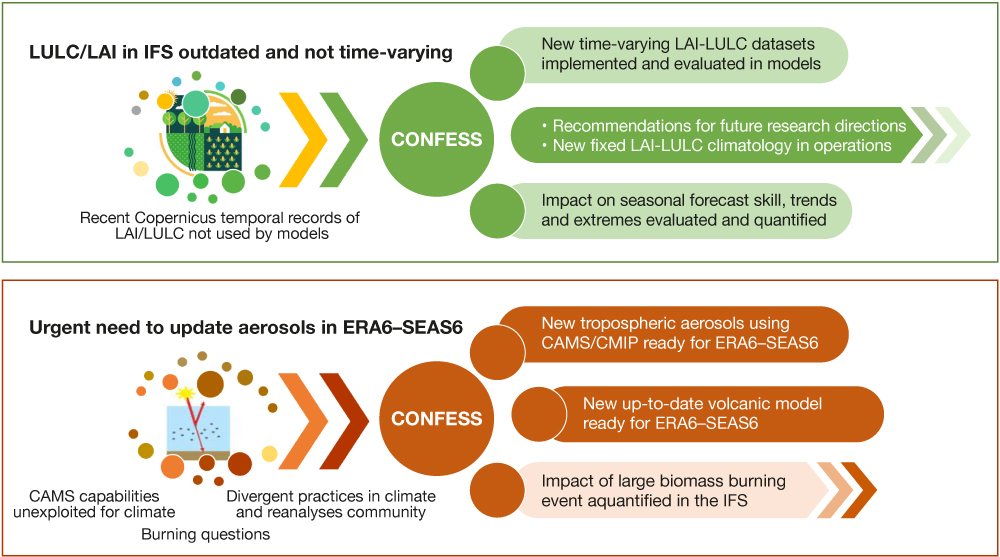Radiative forcing, land cover/use and vegetation are prescribed as boundary conditions in reanalyses and subseasonal–seasonal–decadal integrations. Their temporal variability impacts the solution. There are new high-accuracy observational datasets for the recent period (the last 20–30 years), which are not yet used in reanalyses and re-forecasts. To facilitate the seamless approach adopted by ECMWF, there is a need to create time-varying records which are consistent with those used in operational medium-range prediction. There is also a need to find the best and converging practices between the operational centres providing reanalyses and seasonal forecasts and the wider climate community. These have been the motivations for the activities in the EU Horizon 2020 project CONFESS (https://confess-h2020.eu/). CONFESS aimed to improve the representation of global trends and regional extremes in the next generation of Earth system reanalyses and seasonal forecasts made available by the EU-funded Copernicus Climate Change Service (C3S) implemented by ECMWF. It has done so by taking stock of observational datasets and model developments across different Copernicus Services on vegetation, land cover, atmospheric composition and biomass burning.
CONFESS comes to an end in the spring of 2024, and it is time to review its legacy. The achievements of CONFESS have been possible thanks to the engagement and expertise of the project partners: Météo-France, ECMWF, Italy’s Institute of Atmospheric Sciences and Climate (CNR-ISAC), and the Barcelona Supercomputing Center (BSC).
Land cover/use and leaf area index
CONFESS has managed to identify and harmonise different datasets of land use/land cover (LULC) and leaf area index (LAI). The implementation of these datasets in different models has allowed coordinated experimentation in a multi-model framework, resulting in the quantitative assessment, for the first time, of the impact of time-varying land properties in multi-year land simulations and seasonal forecasts. The multi-model assessment has indicated that time-varying land properties, especially vegetation, have a significant impact on trends, skill and extremes. However, the impact is highly dependent on the model, and there is a further need to quantify and constrain the land–atmospheric feedbacks. Therefore, the time-varying land properties will not be included in ECMWF’s next reanalysis, ERA6, or in its next seasonal forecasting system, SEAS6. They are, however, a key component of further developments for ERA6-land and ERA7. The most recent period of the CONFESS LULC and LAI datasets, treated as a fixed climatology, has proved beneficial for numerical weather prediction and will go in the next operational cycle of ECMWF’s Integrated Forecasting System (IFS), Cycle 49r1, and will therefore be inherited by ERA6 and SEAS6. The LAI has also been used in decadal integrations by partners in the Italian National Research Council (CNR), and to evaluate the quality of the prognostic vegetation models used by Météo-France.
Tropospheric aerosols
CONFESS has also enabled a major step in the treatment of time-varying tropospheric aerosols, by merging the capabilities for the EU‑funded Copernicus Atmosphere Monitoring Service (CAMS) implemented by ECMWF, our current reanalysis (ERA5), and the latest repository of tropospheric aerosol emissions (an update to CMIP6, likely to be used in CMIP7). The aerosol optical properties in the IFS have also been revised (see the article on a new time-varying tropospheric aerosol climatology in this Newsletter). This new dataset will be implemented in IFS Cycle 49r2, to be used in ERA6 and SEAS6. Having an up‑to‑date aerosol climatology that is consistent with the latest CAMS aerosols also helps us to explore the impact of interactive aerosols on numerical weather prediction.

Hazardous events
The activities in CONFESS have also made steps towards enabling prediction and monitoring systems to react to hazardous events, such as large volcanic eruptions and biomass burning. A new model for volcanic stratospheric aerosols (EVA_H) has been implemented in the IFS. This made it necessary to revise the aerosol optical properties. The EVA_H model has been thoroughly evaluated in seasonal and decadal forecasts, and it will be used in SEAS6 re‑forecasts. It has also been possible to quantify the impact of large biomass burning emissions in sub-seasonal and seasonal forecasts. The results, based on experimentation with prognostic aerosols in the IFS targeting three case studies, show that although there is a noticeable impact on predictions of local surface temperature, the amplitude is modest and it does not alter the large-scale atmospheric circulation. But this work was done before revising the IFS aerosol optical properties, and it should be repeated with more recent upgrade Cycles.

